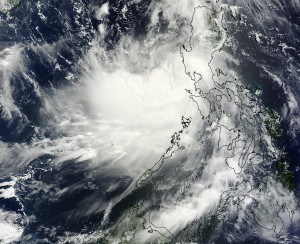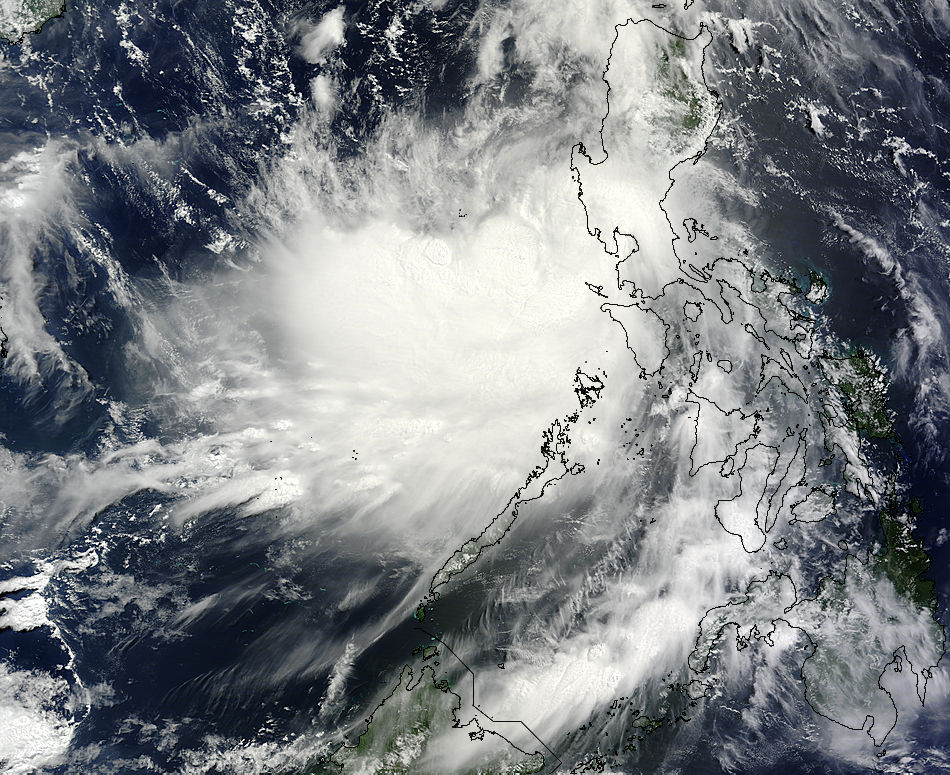Haunted by last year’s devastating storm, hundreds of thousands of Filipinos fled from disaster-prone areas Tuesday in advance of another typhoon due to hit the northeast at nightfall before barreling across densely populated regions toward the capital.
There were no immediate reports of casualties, but three fishermen were declared missing after they failed to return to shore as fast-moving Typhoon Rammasun, which was packing sustained winds of 130 kilometers (80 miles) per hour and gusts of up to 150 kph (93 mph), hurtled toward Sorsogon and Albay provinces.

Image Credit:
NASA Goddard MODIS Rapid Response Team
About 300,000 people moved to safer ground from their homes in Sorsogon, Albay and four other provinces threatened by flooding, landslides and storm surges, many of them wary because of the widespread deaths and destruction wrought by Typhoon Haiyan in the country’s central region last November, officials said. Haiyan’s strong winds and tsunami-like storm surges flattened towns, leaving at least 6,300 people dead and more than 1,000 missing.
Albay, about 340 kilometers (212 miles) southeast of Manila, the capital, has had its share of major disasters. Mudslides from Mayon, the country’s most active volcano, buried villages during a 2006 typhoon and left about 1,600 people dead and missing.
“I got scared because our house was being pounded by strong wind and rain. We went and got drenched in the rain,” Lucille Navarro, a 35-year-old mother of two, said by cellphone Tuesday from a crowded evacuation shelter in Albay’s Daraga town, where she brought her son and daughter.
Alexander Pama, executive director of the National Disaster Risk Reduction Management Council, said many villagers, mindful of past disasters, cooperated and moved rapidly when told to evacuate. But he added that he was concerned the typhoon would roar through some densely populated regions in the dark.
Many areas shut off their power deliberately, while the others lost electricity as wind and rain began to pummel coastal communities.
Schools suspended classes in several cities in the typhoon’s expected path, including Manila, and about 50 domestic flights and four international flights were canceled due to bad weather.
The first impact from Rammasun is expected to be felt in metropolitan Manila early Wednesday, with the storm forecast to blow across or near the flood-prone capital of 12 million people before passing through rice-growing northern provinces. It is expected to start moving over the South China Sea on Thursday.
(Associated Press writer Oliver Teves contributed to this report.)
Was this article valuable?
Here are more articles you may enjoy.


 Oregon Schools Sued for $9M After Young Girl Allegedly Raped
Oregon Schools Sued for $9M After Young Girl Allegedly Raped  Dog-Related Injury Claim Payouts Hit $1.12B in 2023, Report Shows
Dog-Related Injury Claim Payouts Hit $1.12B in 2023, Report Shows  California Chiropractor Sentenced to 54 Years for $150M Workers’ Comp Scheme
California Chiropractor Sentenced to 54 Years for $150M Workers’ Comp Scheme  Justice Department Preparing Ticketmaster Antitrust Lawsuit
Justice Department Preparing Ticketmaster Antitrust Lawsuit 